Orange blossom ice cream (or “In praise of Arrowroot”)
Floral ice creams may not be all that common. But if you like Oriental desserts, you have likely already come across the Orange blossom flavour. Since I happen to adore this dreamy, aromatic stuff, it was just a matter of time before it would end up in an ice cream. And what an ice cream it turned out to be! This particular adaptation of the popular Sicilian gelato combines a low-fat content with a shining visual appeal and a rather peculiar consistency. Peculiar consistency? Yes, because contrary to all established advice, I decided to use Arrowroot instead of corn starch. And I am really glad that I did!
Orange blossom water is usually found in places selling Oriental food ingredients, and looks pretty much like water.
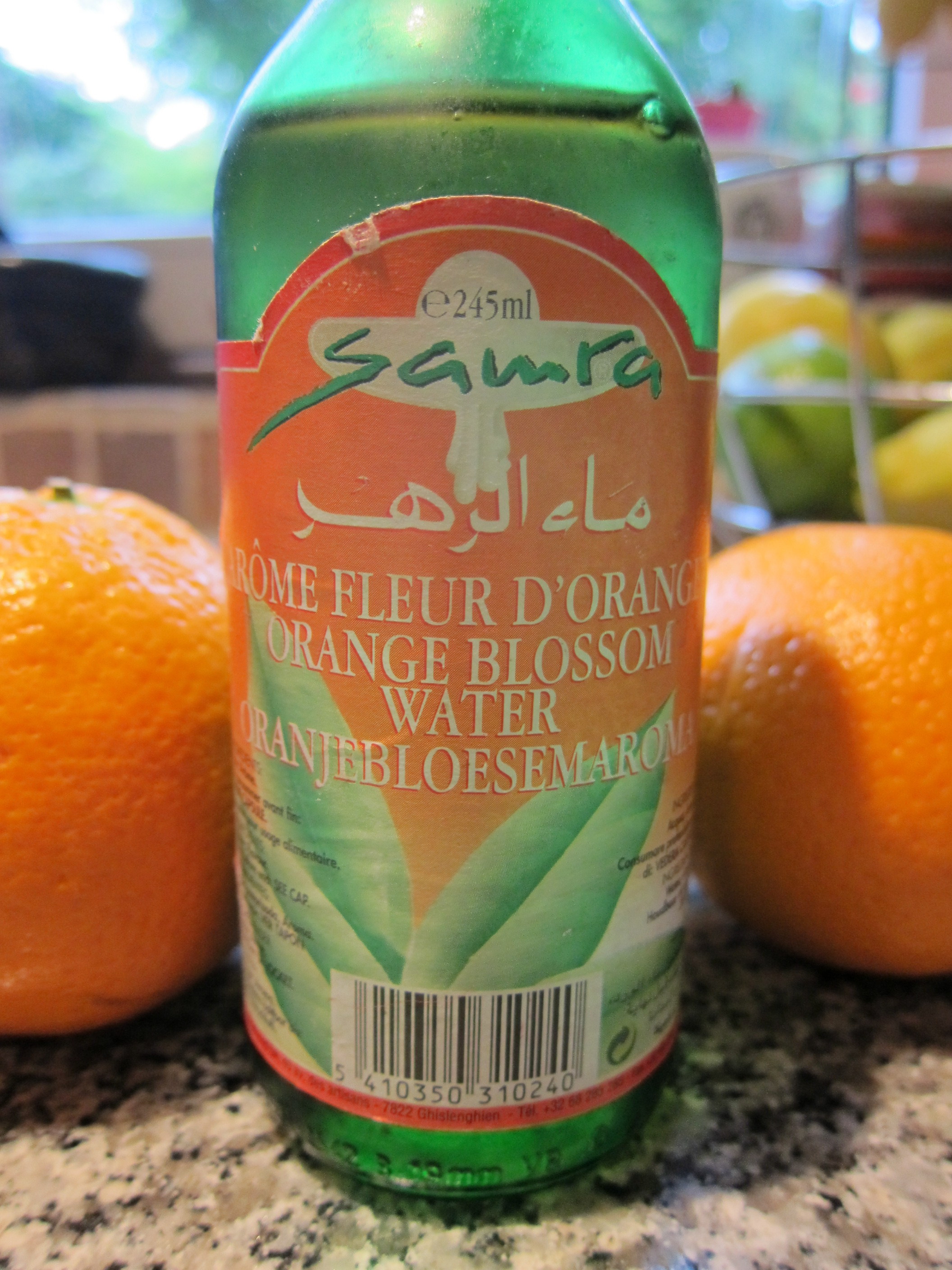
Orange blossom water is the result of steam-distillation, and thus a natural product. Qualities may shift, however, so try to find a good brand.
The ‘water’ is highly aromatic, almost like a perfume, and you might be excused for believing it to be some kind of artificial flavouring best avoided. But it is actually quite natural – the ‘water’ is the aromatic steam distillate of orange blossom flowers (with the flowers usually coming from bitter-orange trees).
Since I mainly associate the fragrance with Oriental desserts, I decided to use a variation of my Sicilian gelato as base for the ice cream. But this time, I decided to be inventive! Instead of turning to my normal choice for starch (corn starch), I was curious to see what would happen if I used another type – Arrowroot!
Why this curiosity? Because I had read several texts warning against the use of Arrowroot together with dairy, since that apparently was likely to lead to a ” slimy consistency”. “Slimy consistency”, however, somehow seemed quite fascinating, and I had a feeling that this actually could benefit the type of ice cream I had in mind. Well, there was only one way to find out!
My new best friend for stabilising ice cream – Arrowroot
Arrowroot is basically starch derived from the rootstock of certain tropical plants. One explanation for the name is that it refers to its early use by Caribbean tribes to treat arrow-wounds, since the starch had the ability to draw out poison from the arrows.

The Arawaks – one of the indigenous people of the Caribbean credited with the early use of Arrowroot (allegedly to cure poisoned arrow wounds)
Used as a stabilising agent, Arrowroot comes packed with positive qualities. Pure Arrowroot is distinctly white and lacks both taste and aroma. Unlike corn starch, it stabilises at lower temperatures (thus, does not require as much heating as corn starch). And again unlike corn starch (if not sufficiently cooked), Arrowroot does not leave any traces of “starchy-floury” flavour whatsoever. On top of that (and once again, contrary to the matte effect of using corn starch) using Arrowroot would also give a shiny appearance to your product.
Sounds great, does it not? And yet, the only times I had seen Arrowroot recommended for ice cream making was in vegan recipes. And all because of the purportedly slimy outcome when Arrowroot was combined with dairy. But could that really be so bad? After all, some Oriental ice cream (like the Greek Mastic and the Turkish Dondurma) are stretchy to their nature. No time to waste – I put together a base, using Arrowroot instead of corn starch and – gulp! – combined it with milk!
As to its practical use in ice cream, Arrowroot – like all starches – should be whisked and diluted in a little cold liquid (= here, some of the milk used in the recipe). Set that aside and bring the rest of the ice cream base (here basically milk, sugar, a little vanilla and a pinch of salt) to the level of “steaming hot”. Now, quickly whisk in the milk with the diluted Arrowroot and continue to cook the mixture – while whisking the base – for about 2-3 extra minutes. The base should be kept hot but not boiling, since Arrowroot begins to stabilise at lower temperatures than, say, corn starch. Prolonged, or too much, heating will actually diminish the stabilising effect (the same applies to corn starch, but Arrowroot is more delicate also in this respect). But in my experience, a couple of minutes or so of cooking the starch only seem to aid the stabilisation process.
Once taken off the heat, the base should be cooled down as quickly as possible. This would also be the point when I add the orange flower water to the base. Once cooled down, chill the base in the fridge for a few hours or preferably over night.
If not already evident before, the “slimy” qualities of the arrowroot-dairy mixture should by now be clearly noticeable. If you have used a bit too much Arrowroot, the base could well have taken on an almost blob-like character (like a semi-solid, clingy mass of jelly). Using a “correct” amount of Arrowroot will not produce such blob-like effects, but you will be able to notice that the texture (for lack of better examples) somehow resembles that of viscous toy slime.
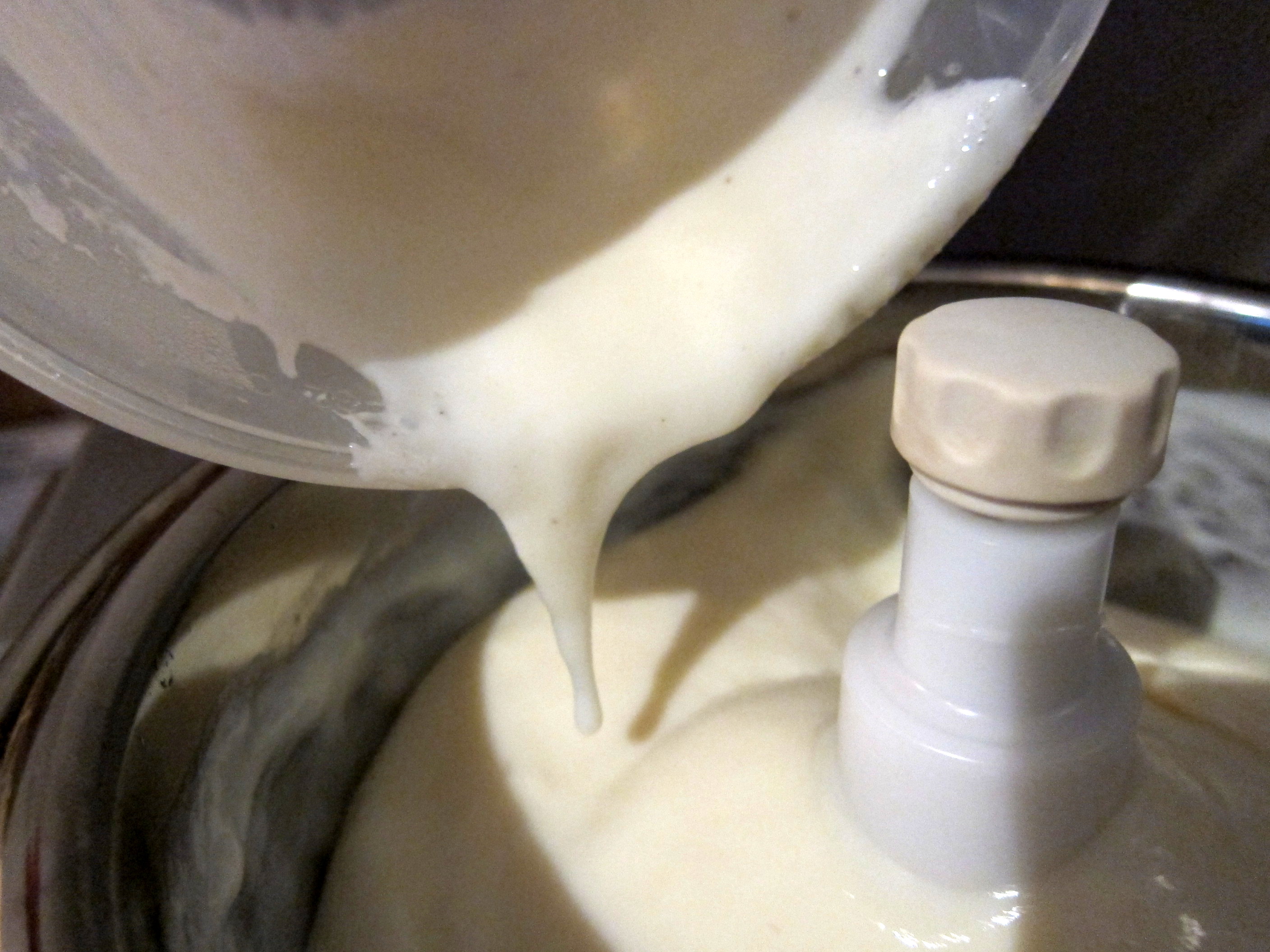
Churning the milk-based ice cream, stabilised with Arrowroot: Notice the “slimy” general consistency.
Worried about the ‘slimy’ aspect? Well, have no fear! First of all, this ‘slimy’ texture is actually quite nice: eating the ice cream freshly churned and still quite soft could give you an entertaining, somewhat different experience of texture and mouthfeel – try it: you may well come to enjoy it. But even if you still would prefer a more ‘typical’ ice cream consistency, just let the ice cream spend a little time in the freezer. Freezing will affect the consistency and make the ice cream firmer in shape, including doing away with most of the “slimy” characteristics.
The stabilising capacity of the starch provides for excellent shape-retention and a pleasant mouthfeel. The texture might come across as slightly “chewy”, which in many ways remind me of the positive and intriguing chewiness of some Oriental ice creams. And best of all – the Arrowroot leaves no flavour marks whatsoever of its own!
I can also confirm that Arrowroot does give a shiny finish! As you may glean from the pictures below, the surface of the ice cream is practically shining bright: a very nice effect when dealing with ice creams, if you ask me.
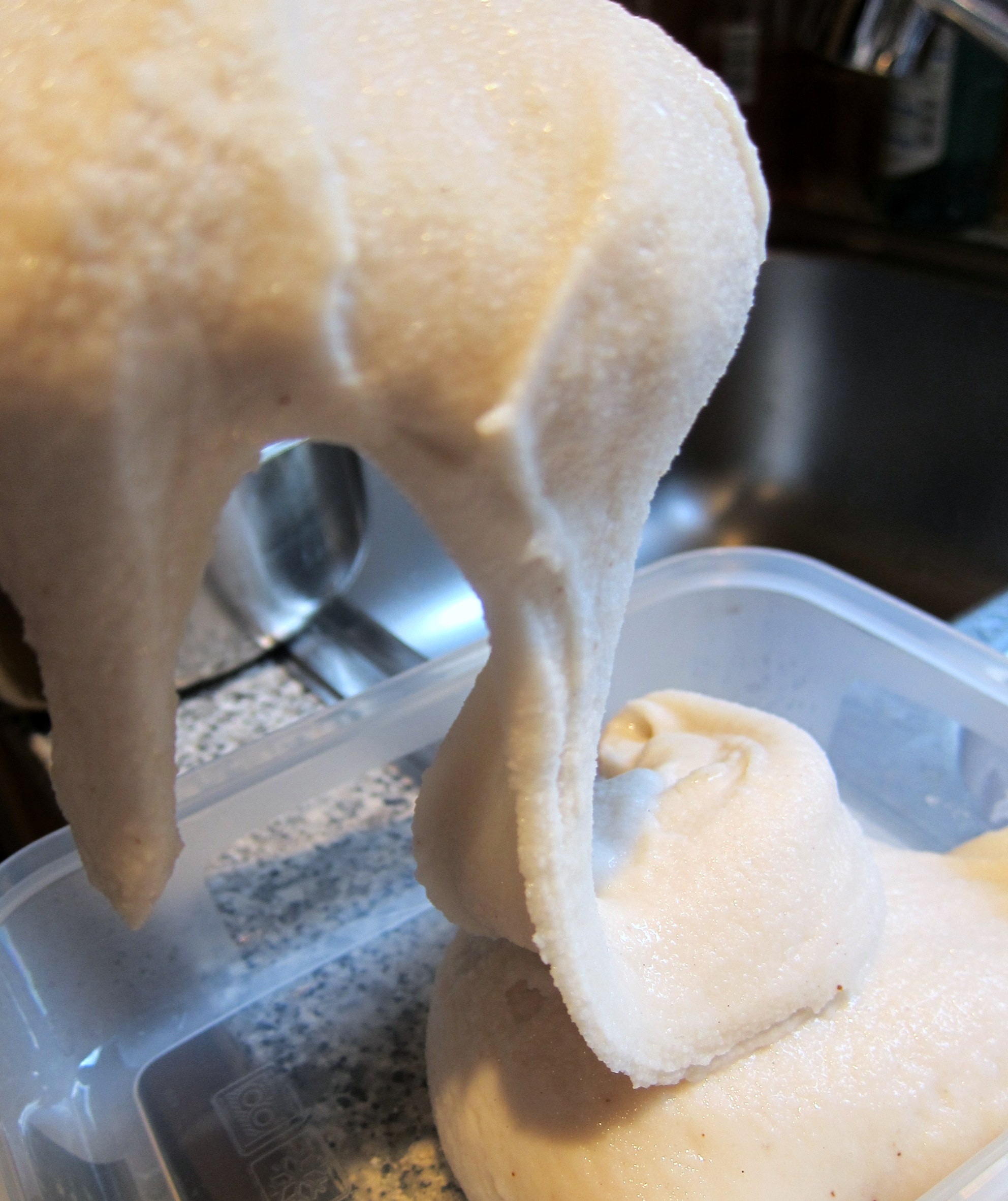
Intriguing stretchiness (in a nice sense!) and a vivid, shiny appearance makes this ice cream based on Arrowroot starch stand out
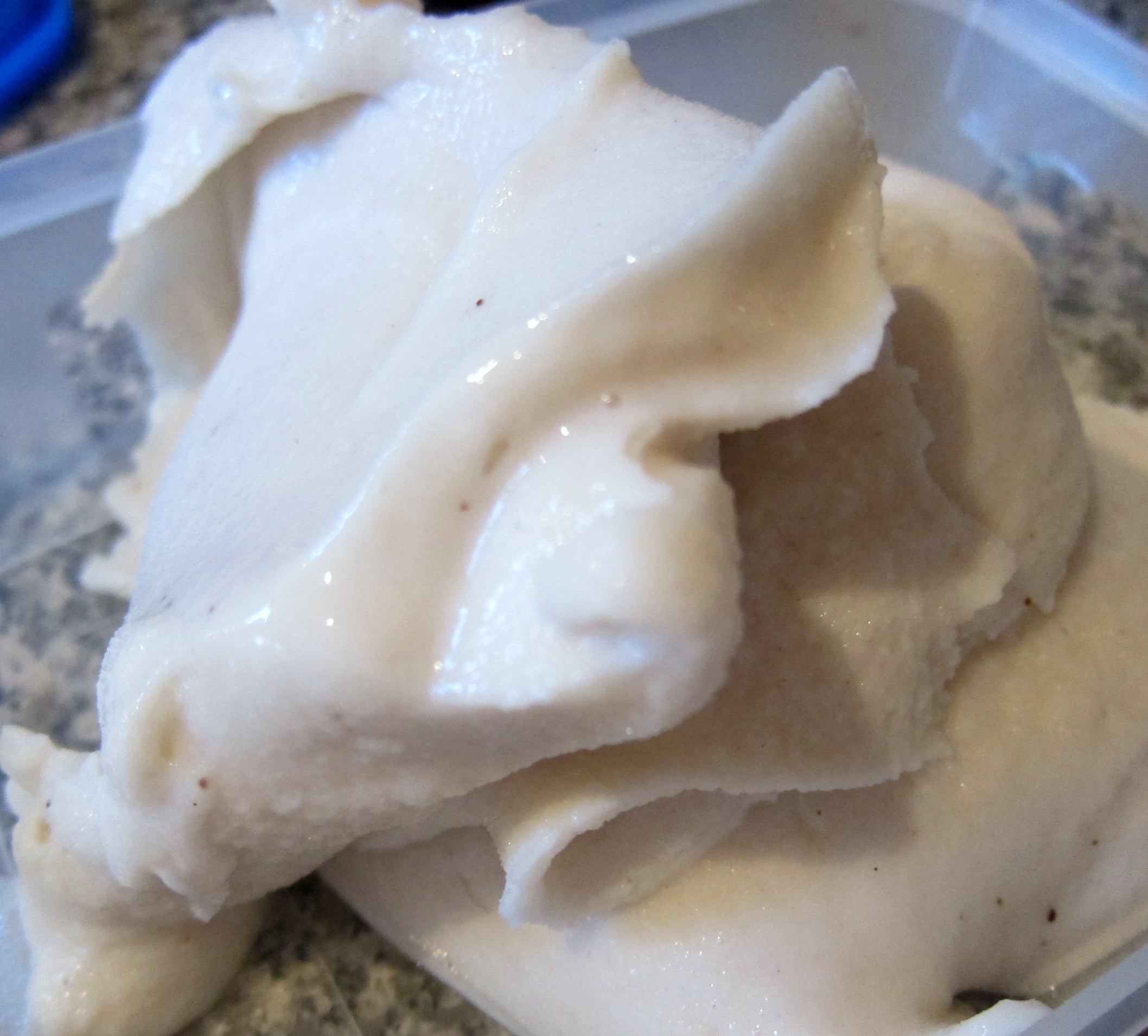
Shape-retention is notably good (particularly considering that the ice cream is made up of milk only).
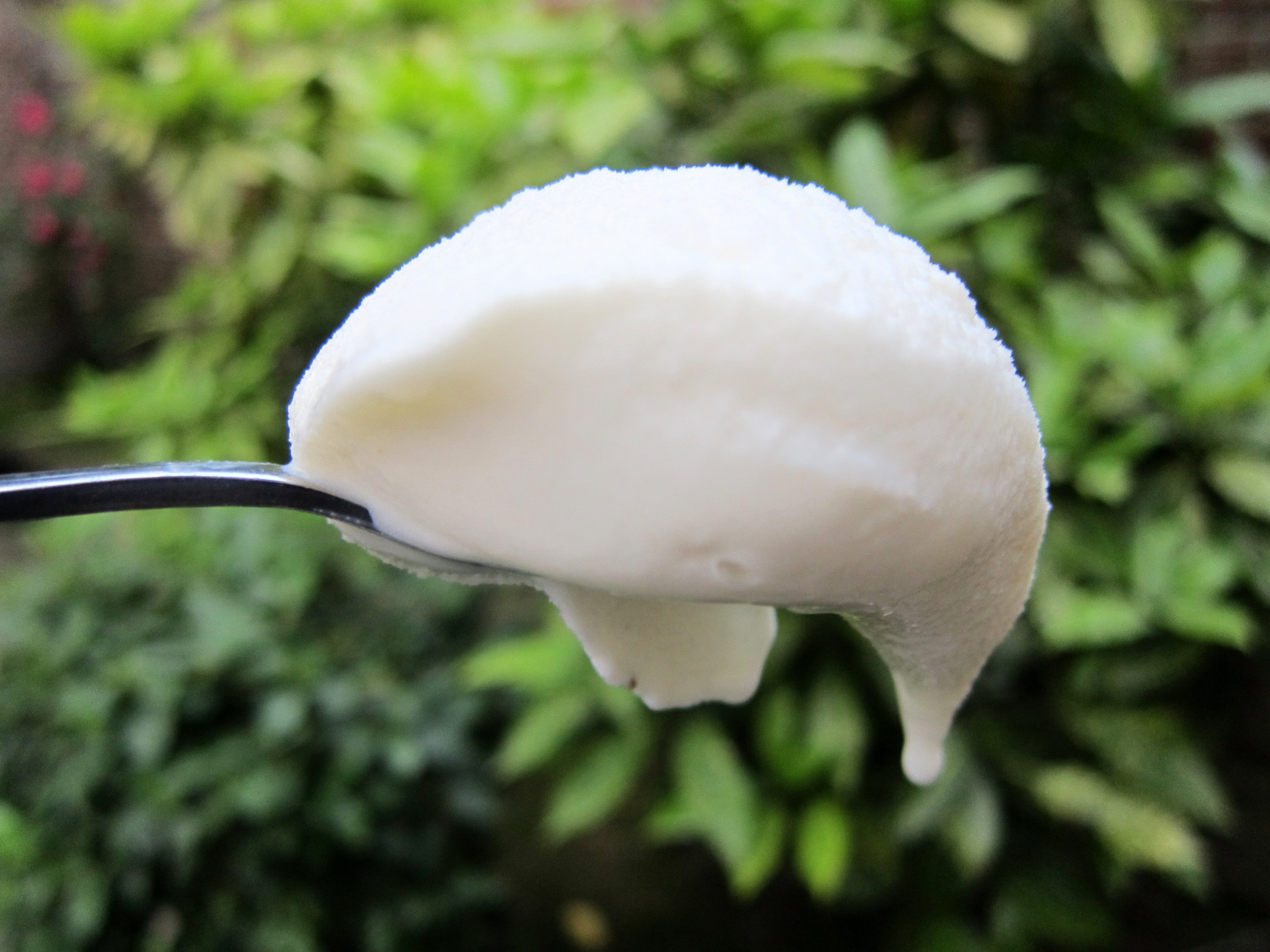
Orange blossom ice cream, Sicilian gelato-style (the Arrowroot variety): Pure as snow, and with small ‘wing-tails’ that hint about the peculiar texture
And the orange blossom flavour? Oh – it turned out like an enchanted dream from Arabian Nights! In fact, I have already started to lose track of how many times I just had to make another batch of this truly terrific flavour. But then, how could it be less than great with such a superb base?
The starch of the Arrowroot contributes to a spectacularly well-suited ice cream base, imparting a nice chewiness and mouthfeel to the floral flavour which otherwise might have come across as a bit ‘thin’. Now, it was just perfect! And notice that the ice cream remains truly light in terms of calories – no cream, no eggs … just milk, sugar and Arrowroot.
Arrowroot has clearly sailed up as my new favourite ingredient for making Sicilian gelato-style ice cream. All that I have mentioned – the pleasant mouthfeel, the smoothness and the total lack of any additional starchy flavour – make up a perfect, basically foolproof, ice cream base for most any flavour one could imagine. And I like the glossy shine.
So, dear fellow ice cream lovers: let’s break the conventions and put some Arrowroot in our ice creams!
- 700 ml (about 3 cups) whole milk [optionally, substitute some of the milk for cream, which will make the ice cream richer (and fatter). I would only replace 100-200 ml, by the way. ]
- 125 ml (a full ½ cup) sugar
- about 5 tablespoons of Arrowroot starch [or other suitable starch, but then you lose out on the funny consistency and the shining finish]
- pinch of salt
- ⅓ teaspoon of genuine, pure vanilla powder
- about 4 tablespoons of orange blossom water
- Whisk together 200 ml (about 0.8 cup) of the cold milk with the Arrowroot starch, making sure that there are no remaining lumps. Set aside for now.
- Blend the remaining 500 ml (about 2.1 cup) of the dairy, the sugar, the salt and the vanilla in a sauce pan. Warm until steaming hot (not boiling!) on medium heat.
- Blend the Arrowroot starch mixture with the rest of the ingredients in the sauce pan and whisk away. Since Arrowroot thickens at lower temperatures than corn starch and also does not react well to overheating, limit the continued cooking to a couple of minutes or so).
- Whisk well, add the orange blossom water and let the mixture cool down. Refrigerate the base for a couple of hours, and churn according to the instructions of your ice cream machine.
- In case you have no ice cream machine, still-freeze the base in your freezer (see the post on how to best make ice cream without an ice cream machine). By the way - like Sicilian gelato in general, the base is perfect for still-freezing!
- After the churning, place the ice cream in a freezer-safe container, cover with plastic film and a lid, and store in the freezer.

Hurry to the frozen flying carpet! The Orange blossom ice cream evokes pleasant associations to Arabian Nights

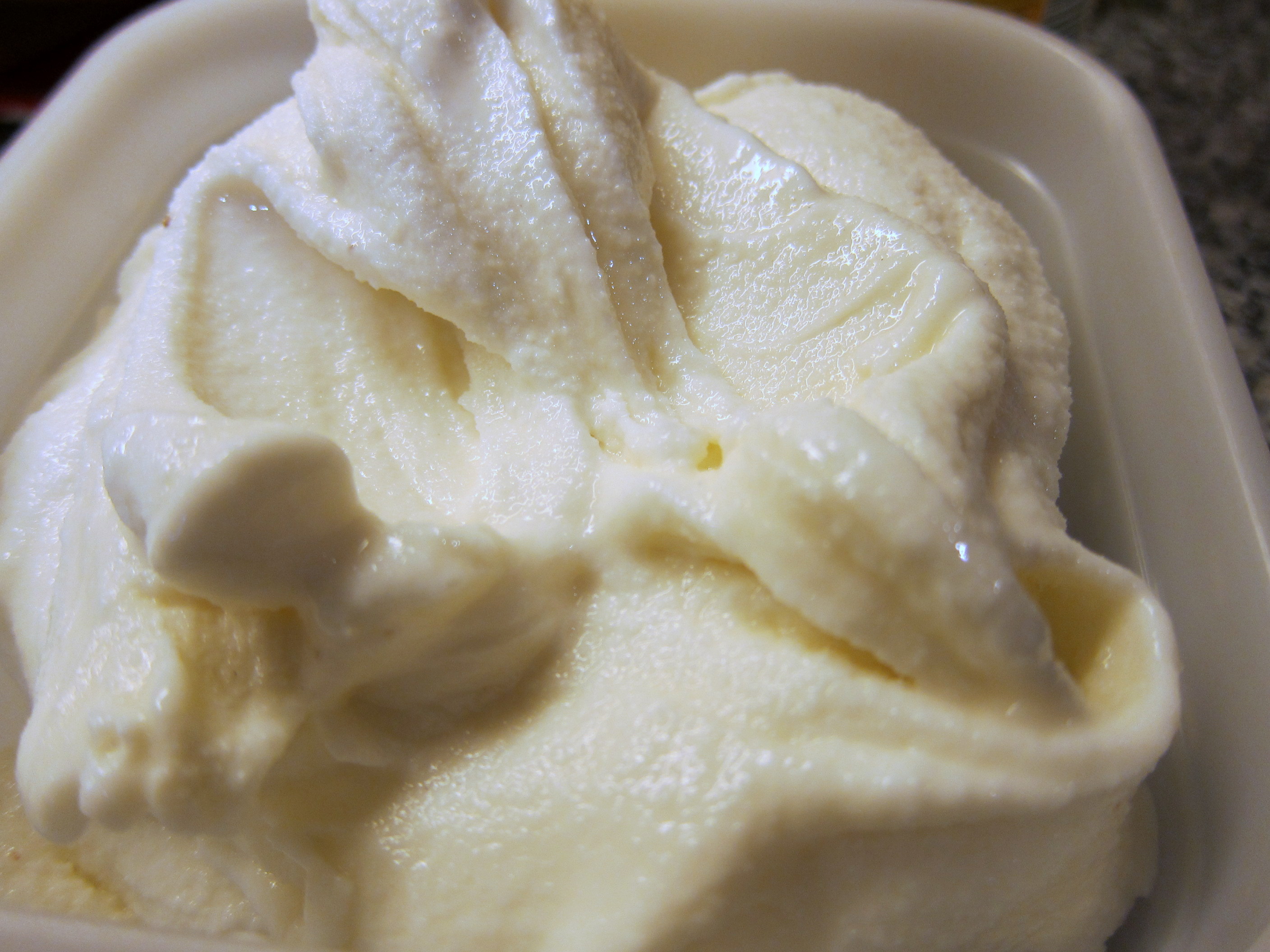
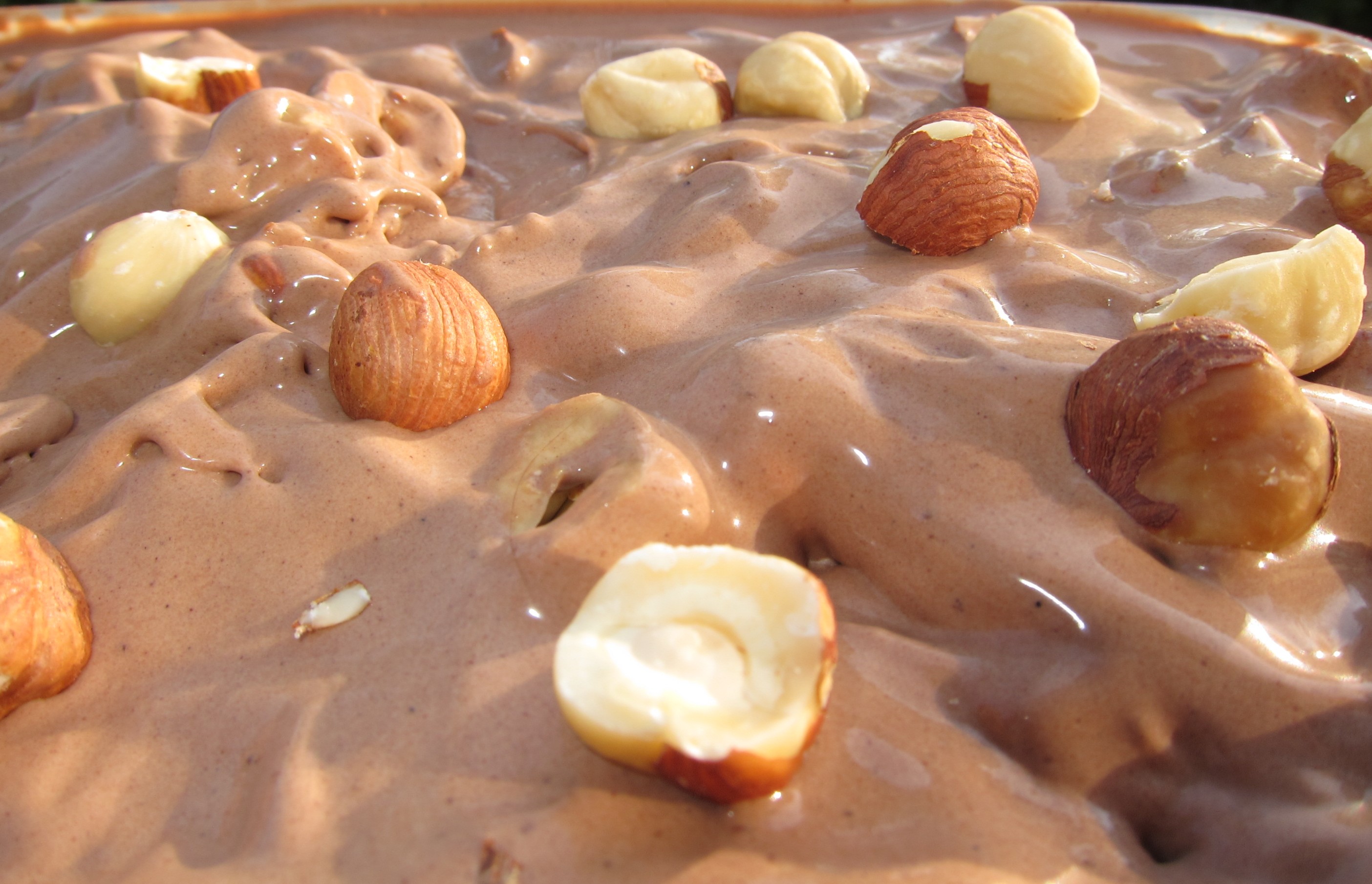
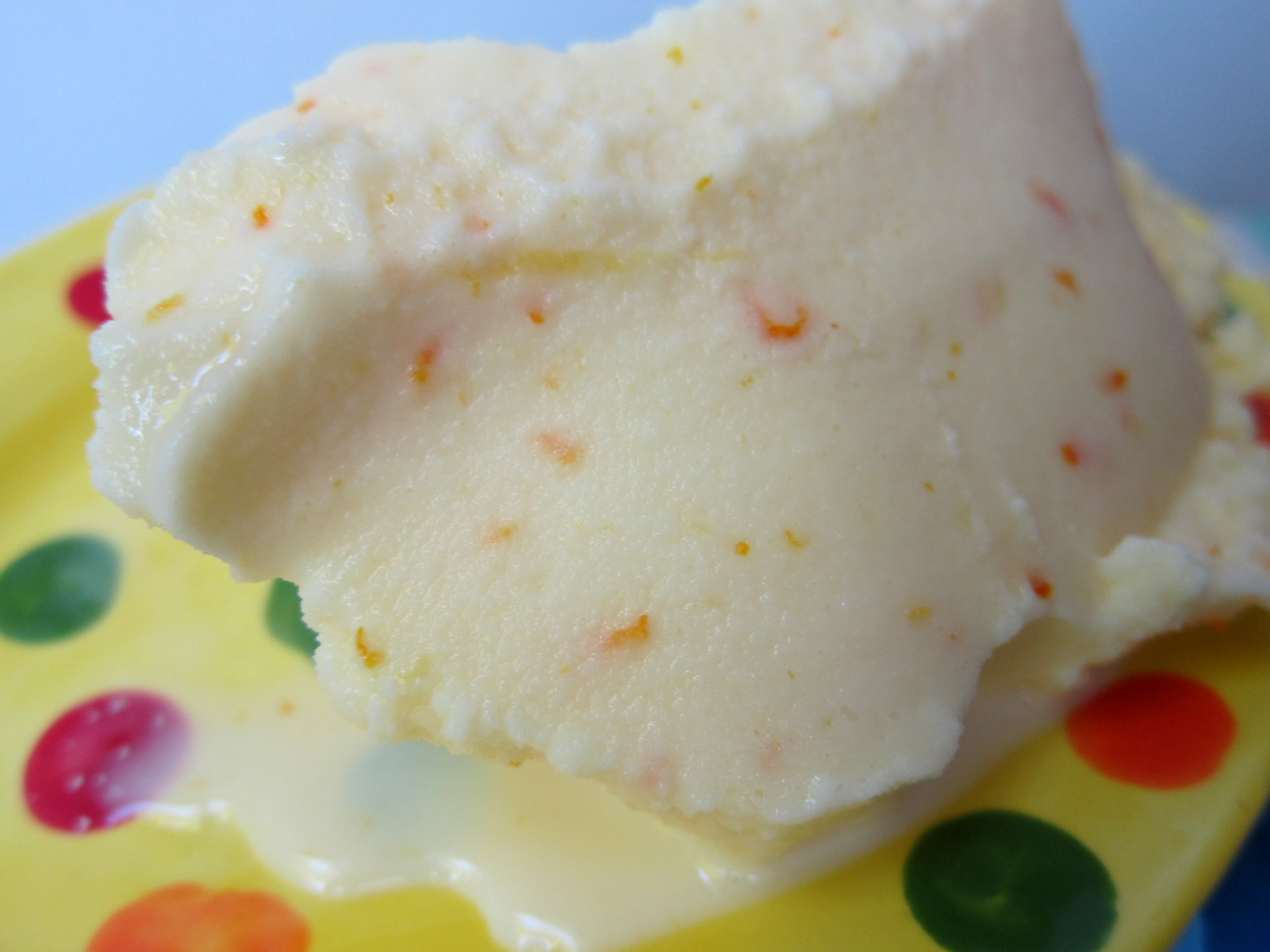



I really like your experimental spirit!
Thank you Katerina! Coming from you, that means a lot to me 🙂
Anders
This is very similar to your Italian Gelato style using cornstarch – just wondering what you think about any differences between the two. I have made the Gelato using cornstarch with a 50/50 mix of heavy cream (35%) and milk (4%) and been pleased with the result — but I also have made one using only milk (at 4% fat) and was disappointed with it. IT was “OK” — but needed some more fat.
Barry,
As you probably have noted, I am generally very happy with the results one achieves with the Sicilian gelato base. The base is versatile, does not “stand in the way” of the flavours used and typically provides excellent shape-retention and smoothness. If no ice cream machine is at hand, this type of base is also my clear favourite. The differences between different types of starch basically come down to the ‘peculiarities’ of those starch-types: a lot is already covered in the post but generally speaking, corn starch demands a little bit more attention, since there is a possibility that ‘under-cooked’ corn starch adds a floury taste to the ice cream (not so for Arrowroot). Corn starch also gives a matte shade to the colours of the ice cream, whereas Arrowroot adds a shine. The consistency difference has been covered in the post 🙂 .
And I am very happy that you have found proportions of milk/cream that you like! In terms of the ‘structure’ of the ice cream, the starch (whichever type one uses) will generally take good care of the consistency regardless of the exact proportions of milk and cream. In other words, choosing the proper level of cream should largely be a matter of personal preferences, possibly also taking into account what kind of flavour one is about to create.
Hello Anders,
Thank you for this great recipe! As a complete noob with eggs, the Sicilian style was perfect for me 🙂 And this version truly was better, as it doesn’t have that flour flavor of the cornstarch.
I tried the Scandinavian Vanilla recipe but with this base instead, and it was wonderful. I used tapioca starch instead of arrowroot, and it worked quite well.
Thanks again!
Jessica, I’m very happy to hear that you liked the recipe (it is one of my own clear favourites too 😉 ). As you’ve already noted, it is really versatile and can be used with good results for a lot of different flavours. Fun to hear about you using tapioca too – did you notice any particular differences compared to when you used the other starches?
Hello Anders,
Truly, it’s very versatile. I decided to try with tapioca mainly because I’m not familiar with arrowroot, but I’d heard they could be used interchangeably.
Tapioca starch was very similar, if not the same, as to what you’ve described with arrowroot. I used the same quantity as well, and it thickened very quickly. Once heated, the mixture reminded me of thick condensed milk. Maybe it’s not as slimy? The ice cream was also a just a little chewy.
By the way, I thought about suggesting a flavour 🙂 Have you ever heard of sweet corn ice cream?
Jessica, thanks for sharing your tapioca experience!
I’ve heard about, but never made any, sweet corn ice cream -so, all the more reason for keeping your suggestion in mind when contemplating future experiments 🙂
Hello Anders,
I thought I’d try a recipe, and had good results with it 🙂
In my home country, Brazil, this flavor is very common due to the winter festivities, the “Festa Junina”, in which most delicacies are made of corn. However, it’s used the young corn (“milho verde”), which isn’t very sweet at all.
Now living in the United States, I used canned corn kernels instead. The corn here tastes much sweeter. As such, I made an ice cream in the style of one of those delicacies instead, the Pamonha. One possibility is to add a bit of cinnamon on top, it will taste like the Curau instead.
This is the amateurish experimental recipe I used:
My “Pamonha Ice Cream” 🙂
– about 300g sweet corn kernels (one can)
– 350ml whole milk
– about 200g sweetened condensed milk
– 1 leveled tablespoon of tapioca starch, maybe even less
– a pinch of salt (for a salty-sweet flavor)
It’s very simple. The corn will thicken on its own. The tapioca here is for that chewy consistency.
Put the corn, condensed milk and most of the whole milk into the blender. Once blended, you must cook it for some time, about 5 minutes, for the flavor to stand out.
Here I let it stop boiling first then added the tapioca.
Once cooled, I tried putting it in my ice cream maker, but the machine couldn’t churn it. I put the whole thing in the freezer instead. After about one hour, it had a good consistency.
In my second experiment with this recipe, I used 500ml of milk instead, to see if it would churn. It did, but it didn’t taste as good.
I hope you enjoy it. Feel free to change or improve it! ^^
Thank you for sharing the arrowroot technique Anders! I used the base in a bit of an experiment today: goat milk ice cream. I used honey instead of sugar, and no orange essence. I wasn’t sure how the honey would substitute and it is a bit sweet at 1:1. If I make it again I would use 1/4-1/3 cup. That said, the flavor and texture are excellent! It’s a great use of goat milk if you happen to have it.
Dear Anna, happy to hear about your successful goat milk-version!
As to honey-sugar conversion, a conventional rule of thumb recommendation is to use about 3/4 of the sugar amount (i e 1 cup of sugar translates into 3/4 cup of honey). Given the special flavour of honey, and its inverted sugar characteristics (relatively more powerful anti-freeze per amount, compared to ‘ordinary’ sugar), some also prefer to only replace a part (like, 1/5-1/4) of the ice cream’s sugar with honey. But then again, this depends on the particular flavour and one’s personal preferences (as your excellent honey-goat milk ice cream well proves 😉 ).
Ah, thank you for the honey guidelines! I appreciate you going into the science behind the different ingredients. It’s not only interesting, but helpful for experimenting and improvising as well. 🙂
Hi. I am brand new to icecream making. I’d like to add gelato to my chocolate shop. I made a batch of vanilla using half cream and half milk and arrowroot. I am very happy with the result. I heated mixture to 85 degrees. What do you think the shelf life of gelato is using this method?
Hi Richard,
While good preparations certainly can contribute to the shelf life of ice cream (and the starch based recipes are good in this respect), the main thing that typically shortens shelf life is storage! And it is usually quite visual too – the cue that an ice cream is past its prime tends to be the frost-like iciness which develops over time (we have probably all found some old, previously forgotten, ice cream now seemingly covered in ice crystals in the freezer …). To keep down this unwanted growth of unpleasant ice crystals good preparations/recipe is important. But what might be the most important issue is probably the amount of temperature fluctuations during storage and distribution (so-called heat shock). This is also the big reason for why one never should attempt to re-freeze served, almost melted ice cream … it will re-freeze, but in a coarse, off-putting way. Anyway: if you do your best to avoid the heat shocks, your ice cream could possibly last in the freezer for quite a long time without any problems.
Hi
I have question :
I have my own recipe for the ice cream , and I don’t use the heat .
Can I just add the arrowroot to the recipe without heating it ?
Daiv,
You may well try, but as far as I know you would normally need the heat in order to properly trigger the “thickening qualities” of the starch. If you normally don’t use heat, I suggest that you give it a try: you are likely to notice quite a big difference 🙂
I am very thankful today for the information about arrowroot. I have now tested a recipe for my soft serve ice cream. WOW it worked great, what an ice cream. Nice texture, shiny, creamy.
The arrowroot also solve a big problem for me. When we have few customers and the machine turn on, turn off, turn on to keep the soft ice cream frozen the ice cream gets icy and waterlike. With the arrowroot, wow , it gives perfect ice cream all time 🙂
The only thing we have to do time to time is to whisk the ice cream material in the hopper. If not, it will stay in the hopper.
We have a little ice cream shop in Phuket Town, Thailand where we make liqueur ice cream for restaurants.
Thanks
Per Benckert
Dear Per,
Thanks for the kind words, and I’m very happy to hear about your successful use of arrowroot! Best of luck with the ice cream-making 🙂
Thanks for this wonderful recipe. I substituted the orange blossom water with rose water and made a wonderful rose gelato. I also did 3/4 cup of cream. I also found that 5 TB of arrowroot starch made the mixture a bit too gelatin like after I refrigerated it. After churning, it was better, but I think next time I’ll use 3 to 4 TB and see if I can get a smoother texture. It is still very yummy though. Thanks!
Dear Peter,
Thanks for the kind words. It really is one of my personal favourite recipes too, and using rose water instead of orange blossom water will, indeed, give a very nice rose gelato. Good luck with finding a “personal favourite”-ratio of arrowroot too 🙂
Dear Anders,
I wanted to try this recipe but couldn’t be sure about the amount of arrowroot, do you know how many grams of arrowroot for the recipe?
Thank you
Dear Kenny,
According to conventional wisdom 1 tablespoon of arrowroot = about 8 grams. Hope that helps in your calculations!
Hi there, thank you for all your wonderful recipes. I would like to make a gelato ice cream like the orange blossom but with strawberries. Please could you advise how many strawberries you would use with 700ml of milk and how much arrowroot I would need if adding the extra liquid of the strawberries?
Many thanks
Tania
Dear Tania,
Thank you for your kind words!
I would suggest that you try with about 300 ml of mashed strawberries (at least). Kind of difficult to say exactly exactly how much more arrowroot you would need to add but perhaps you could try with one extra spoon and see if that works for you.
All the best, and good luck!
Hi, Lovely idea to use orange blossom water – will definitely give that a try.
I have a question about consistency when using arrowroot: does it stay soft and sort of amorphous, or does it freeze hard enough to form a distinct scoop? As much as I love soft serve ice cream, there are times when I want to be able to shape it into a quenelle for presentation purposes.
Dear Isaac,
The consistency depends on the temperature, but even though the arrowroot lends a soft and somewhat stretchy/slimy character to the ice cream (in a yummy and nice sense!) when freshly churned, it will freeze hard enough to form distinctive scopes.
Actually, even when ‘softened up’, you should be able to scope it quite well: do give it a try – it is quite a fun treat 🙂
Hi Anders – I am a complete novice at gelato making but have been reading your blog for the last several days as well as a number of other sites. I just bought a Breville ice cream maker and put it to test with an egg based vanilla/cinnamon recipe (& stevia powder instead of sugar due to a diabetic father). It did not come out as smooth/creamy as I had expected and wondering if it has anything to do with not refrigerating the hot mixture before churning it? I used 2″1 milk to heavy cream ratio and cooled it down in an ice bucket instead as we wanted to make the gelato the same evening. Basically, I need to ensure I am using stevia and prefer to do a milk only recipe. I am going to try arrowroot but wanted to see if you had any guidance as to why my prior recipe did not work out as well. Also – if you have any suggestions for a stevia or diabetic friendly recipe – would really appreciate it. thanks!
Hi Khadija,
The site actually has a dedicated post on ice cream for diabetics and other with special sensitivies: Go here and check it out!
In short summary (you can read more about the “whys” via the link above), your consistency problem is likely caused by the (relative) lack of fat and sugar in your recipe: both ingredients typically contribute not only to the flavour, but also to the stucture/texture of the ice cream. Starches (like arrowroot) are great for countering the lack of fat, providing the necessary stabilisation. Sugar-replacement can be a bit trickier, as Stevia simply does not have any of the “structural” benefits brought by sugar. As suggested in the link, you may try adding a little alcohol to get a softer finish, or use xylitol instead of stevia.
Best of luck!
Hi Anders,
I have been looking all around the web for an intensive course to learn how to do a Dondurma but i cannot find any. I want to start an ice cream bossiness which serves Dondurma,
As i can see you are an expert in the field, would really appreciate if you could help me or guide me
Thanks Ander :),
Thanks a lot,
Hi Mahmoud,
Unfortunately, genuine Dondurma requires salep, a flour derived from a special orchid which happens to be on the international CITES list of endangered plant species.
Outside Turkey, it is therefore difficult and most likely illegal to get hold of it. There has been attempts to re-create Dondurma using other ingredients, however. Read more about that, and about Dondurma in the post on Oriental ice cream. Best of luck!
I have to make this recipe 🙂 ( orange blossom ice cream)
sounds too delicious.
could I use full fat coconut milk instead of milk?
I guess the same base would be allright?
what about sugar, I would like to avoid sugar as much as possible but I do not want to use stevia or anything that would
alter the taste of the ice cream.
thank you.
Hi Carole,
Sure, I think you could use coconut milk instead of milk/cream (although this, of course, inevitably will affect the overall flavour in a coconut-direction 😉 ).
It is tricky to avoid sugar, but have you tried xylitol (“birch sugar”)? In my opinion, this is the most “sugar-like” non-sugar sweetener I have come across, and works very well in ice creams too (yes – I do aim to make a post about it someday …). Just avoid over-eating (may cause gas-problems) and don’t feed it to your dog 🙂
I really wanted this recipe to turn out especially given I’ve never used Orange Blossom water in cooking. But, the taste was terrible. Me and the kids could barely get down a spoonful. My guess is the Orange Blossom water cast some very bitter flavors. Not sure what went wrong. The only substitution I made was 1 tsp. of vanilla extract added at the time of churning instead of the called-for vanilla power.
On the bright side using the arrowroot starch was very intriguing and this recipe inspired me to keep experimenting with this technique.
Hi Cody,
Sorry to hear about your negative experience. I’m not sure about what might have gone wrong either. Possibly, it might be a quality issue with the orange blossom water: while the flavour might not be to everyone’s liking (and which flavour ever is?), it should definitely not taste bitterly.
Good to hear, though, that you feel inspired to keep experimenting with the base – it is one of my own personal favourites 🙂
hi, i know its been ages since you posted this recipe- but i just wanted to update my findings. unfortunately i didnt have vanilla extract on hand and decided to make mint ice cream (i hated the mint extract even with other food, idk why i made this bad decision).
so, i used glucomannan which is available easily nowadays as supplement. i reduced the amount to 2 tbsp, since i am using pure glucomannan instead of the starch itself. ( there is a study that suggested about 0.3% gluccie is good enough). 1 replaced one cup of milk for cream.
result? still too much gluccie, it tastes plasticky. maybe i will reduce it to 1/2 or 1 tbsp next time. my mistake to also use mint extract, perhaps if using chocolate, it will cover the plasticky taste. otherwise, i am glad i tested this recipe becuase i wanted to find a good less sugar recipe and your recipe is the only.one i found. thanks and i hope my comment will help!
Hi Sarah,
Glad you liked the recipe, and interesting to hear about your experiments with glucomannan (which I’ve not yet used myself). Best of luck with future batches, which I hope will get you your desired consistency (hopefully also with a flavour you like;-) .
hi again! so i finally got to make the ice cream according to recipe 🙂 only 1/4+1/8 teaspoon pure gluccie needed.. its actually not as finnicky as normal ice cream…tastes delicious…thank you for the recipe . i hope my input will encourage you to try gluccie coz i am an amateur and would love to read your experiments with gluccomannan..
Thanks for the feedback and happy to hear that it worked out well for you! I’ll be sure to keep gluccomannan in mind for the future.
Hej! Hittade denna sidan med stora förhoppningar att ge min glassmaskin rättvisa och jag måste bara säga att du har skapat en helt fantastisk sida! Massa spännande information och fördjupning för den vetgiriga och nyfikna hobbykocken! Läser mer eller mindre sida upp och ned. Har precis satt en turkisk dondurma till kylning efter den stora succen majsstärkelsebaserade gelaton innebar igår. Många tack för din insats!
Hej Mika!
Tack för dina vänliga ord och väldigt roligt att höra att du gillar och känner att du har nytta av sidan 😀 !
Hi Anders
Would appreciate some guidance
This base recipe using starch/arrowroot, is it suitable as a base for flavours in a gelato retail shop using a batch freezer machine?
Can the gelato be kept in a display cabinet and scooped for customers?
We keep in display at 14/15 degrees C, and at end of day in storage freezer, then out again next day
Do you have a sorbet base recipe?
Regards
Tam
Australia
Dear Tam,
I don’t see why it should not work, but to really find out if it fits your particular situation, I would really suggest that you simply test and try it out yourselves 🙂 !
Hi, Anders
So I started off with using half the recipe just for me to try out the recipe without wasting much ingredients in case I don’t like it. It turned out amazing! The consistency turned out exactly as you described! Although, I used almond milk instead of dairy milk since I’m lactose intolerant while I don’t want to use up my lactaid pills at home and I used 1/2 tsp(for half recipe) of pure vanilla extract instead of the vanilla powder and I didn’t use blossom extract. It still turned out great!
However, as I made the whole recipe with the same substitutes I mentioned, the consistency turned into ice crystals after I churned it using my ice cream maker and it turned solid after freezing it for a few hours. Well, I did add 2 tsp of matcha powder in a way to make green tea ice cream while I used there recipe without the blossom water as an ice cream base. I’m thinking it’s either the matcha powder, the the amount of time I had the ice cream mixture churning it, or anything else I’m not aware of? Could it be the matcha powder that led to the ice crystal consistency without any smoothness?
Also, do you have any advice on how to use this recipe as an ice cream base for any flavor you want to make of it? Thanks!
~Lauren
Hi Lauren,
Thanks for posting, and glad you liked the recipe – it is one of my personal favourites!
Not entirely sure about what may have caused your problems but I’ll venture some suggestions you may want to follow up on:
Ice crystals is often an indication that the churning takes too long. This mainly depends on the speed of your ice cream machine, but the time can usually be shortened by pre-chilling the base in your refrigerator before churning.
I doubt that the small amount of matcha powder might be the sole reason for your ice cream turning too solid. And even if it might have contributed a little, I’d think that the main reason probably might have been that you’re using almond milk (which contains considerably less fat than dairy milk). Have you considered using lactose-free milk? Or some “fatter” non-dairy like coconut cream? Or a little soy creamer? And/or using some more arrow root?
Considering ways to increase the overall fat-content is, IMHO, probably the most important point to consider if you plan on using this as a base for any flavour (which should be possible). Good luck!
Try Macadamia nut milk instead of almond milk. Costco sells a good brand. I think it makes the best non-dairy ice cream. I also add a 1/2 little can of coconut cream to a 2-quart recipe. (5.4 oz can) You could easily add the whole can. The non-dairy get hard in the freezer because they have so much water in them. A few seconds zapped in the microwave and you’re good to go, though.
I’d love to try this recipe but I don’t have vanilla powder. I have all the other ingredients. Is the vanilla powder crucial? Can I substitute anything else for it? (I have a quality orange blossom water, but only an imitation vanilla essence at home). Any advice?
Hi Shelly,
If all you have home is vanilla essence, I’d say you should use what you have and give it a go! (I would, in your situation 😉 )
thanks, will do!
P.S. As tablespoon and teaspoon measurements vary between countries (ie. Australia/USA etc..) is there any chance you could add (maybe in brackets?) the amount in grams and ounces (so people from different countries will know what the measurements are). If so that would be great! If you could perhaps let me know here what your tablespoon and teaspoon measurements are in grams i would appreciate it!
Shelly, you are right that measurements differ between countries and regions and this creates a bit of a headache: one being how many different measurements I should include in a recipe 😉 .
This is a bit of a dilemma – grams is certainly an idea, but I fear that many readers prefer the “simplicity” of a reference to teaspoons/tablespoons – and no need to use a scale – to the exactness of grams 😉 . When making small batches, the relative differences will typically not create upsetting problems anyway (teaspoons tend to be 5 ml, the US or European tablespoon is 15 ml, and the Australian tablespoon 20 ml). Unless otherwise indicated, since I’m a European, I’ve chosen to primarily go with European measurements but indicate (US) cup quivalents too.